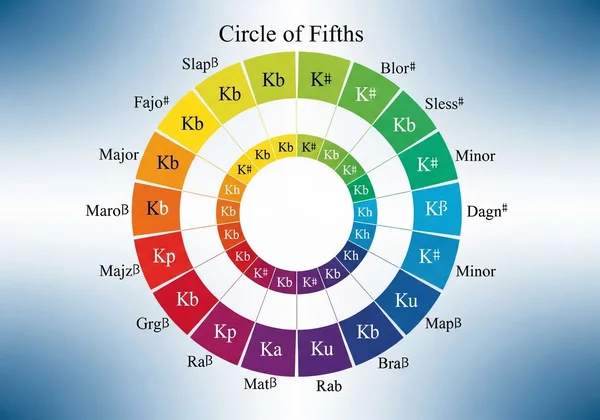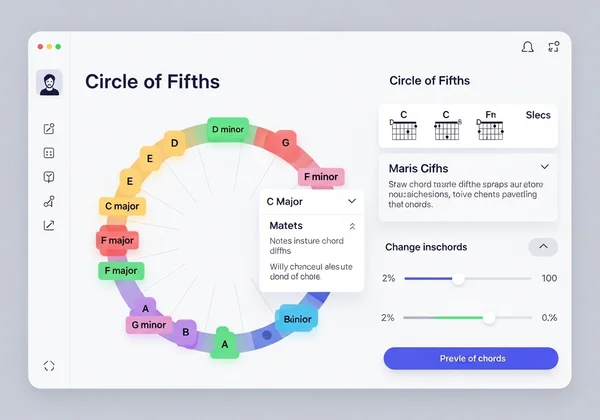五度圆圈解析:流行歌曲和弦进行的音乐理论
你是否曾哼唱一首朗朗上口的流行歌曲,想知道它为何如此吸引人?答案往往在于基础的音乐理论,特别是流行歌曲创作者如何巧妙运用强大的 五度圆圈 来创作那些熟悉而和谐的旋律。这个强大的可视化工具不仅适用于古典作曲家;它是一张动态的地图,揭示了你喜爱流行歌曲背后的隐藏模式。深入了解这些歌曲的音乐蓝图,并探索我们的互动工具如何让分析这些歌曲变得前所未有的容易。
五度圆圈:你的流行音乐分析工具
五度圆圈 是理解流行音乐结构不可或缺的资源。它以可视化的方式组织了所有十二个音乐调性,展示了它们之间的关系以及各自 调号 所包含的升号或降号的数量。对于有抱负的词曲作者、热情的乐理学生或任何乐器演奏者来说,掌握这个基本概念是 音乐分析 的转折点。它能帮助你解读流行音乐的和声语言,让你从被动的听众转变为主动的分析者。

理解流行歌曲的调号
每首流行歌曲都有其特定的调性。这个调性定义了旋律与和声的“家”。理解 调号 是解读歌曲的第一步。例如,G大调的歌曲总会包含一个升号(F#),而五度圆圈清晰地展示了这种关系。它提供了一种直观的方式,用以可视化调性之间如何通过纯五度(顺时针,增加升号)和纯四度(逆时针,增加降号)相互关联。通过我们互动的 五度圆圈图,你可以点击任何调性来即时查看其调号,轻松学习和记忆,并可以在我们的网站上探索调号。
自然和弦:流行音乐的基石
一旦你理解了一首歌曲的调性,下一步就是识别其 自然和弦。这些是在给定调性内自然存在的和弦,由其音阶的音符构成。流行音乐严重依赖这些基础和弦,因为它们听起来和谐且协调统一。最常见的流行 和弦进行 就是使用这些主要和弦:I(主和弦)、IV(下属和弦)和V(属和弦)。我们的工具显示了任何选定调性的所有自然和弦,帮助你快速识别歌曲中使用的和声色彩,并让你即时发现并聆听自然和弦。
五度圆圈揭示的流行和弦进行
流行音乐的魔力常常在于那些熟悉但又极其有效的 和弦进行。这些和弦的序列创造了情感叙事,并赋予了歌曲独特的风格。五度圆圈揭示了这些进行之所以效果绝佳的原因,展示了和弦之间强大的吸引力。

I-V-vi-IV 和弦进行:永恒的流行公式
也许最著名的流行 和弦进行 是 I-V-vi-IV。想想从 2000 年代至今无数的流行金曲,比如 Journey 的《Don't Stop Believin'》或 Adele 的《Someone Like You》——这个进行构成了它们的音乐骨架。在 C 大调中,这会是 C-G-Am-F。五度圆圈优美地展示了这些和弦之间紧密的关系。V 和弦(G)与 I 和弦(C)相差纯五度,创造了强烈的解决效果。vi 和弦(Am)是 I 和弦的 关系小调,提供了微妙的情绪转变。这种进行模式的普遍性证明了其有效性以及它所利用的简单而深刻的和声关系。通过使用我们的互动工具来学习识别这些模式。
为何这些和弦进行听起来“对味”:和声引力
这些常见的 和弦进行 之所以能如此深刻地触动听众的内心,是因为音乐家们称之为“和声引力”或“倾向音”。在某个调性中的和弦会自然地相互吸引,特别是向主和弦(I)移动。五度圆圈以可视化的方式呈现了这种吸引力。顺时针沿着圆圈移动(以五度为单位)会产生强烈的前进感和解决感,最终回到主调。这种内在的音乐逻辑,听众可能常常在无意识中感知,正是这些和弦序列感觉如此令人满意和熟悉的原因。这背后是使流行音乐如此有效的 音乐理论 支撑。
使用五度圆圈掌握流行音乐的转调
流行音乐并非总是静止的;许多歌曲都具有令人兴奋的转调(“modulations”),以建立张力、创造兴奋感或刷新重复的段落。五度圆圈的应用巧妙地延伸到理解和执行这些转换,为导航新的调中心提供了清晰的地图。

流行歌曲中的关系小调与大调转换
流行音乐中最常见且最顺畅的转调之一涉及大调与其 关系小调 之间的转换,反之亦然。例如,C大调和A小调拥有完全相同的调号和自然和弦。在五度圆圈上的这种接近性使得它们之间的联系尤为紧密,便于在歌曲中实现微妙的调性转换。你可以在那些暂时转向更黑暗、更内省情绪,然后在回到大调的明亮感之前,听到这种转换。我们互动的 五度圆圈图 清晰地显示了你选择的任何调性的关系大小调。看看如何轻松地掌握转调。
连接和弦:顺畅过渡的秘诀
为了更具戏剧性但又平滑的转调,流行歌曲创作者经常使用 连接和弦。这些和弦是原始调性和新调性中共有的自然和弦(属于它们),充当了连接二者的桥梁。五度圆圈有助于识别这些在紧密关联的调性之间共享的常见和弦,使过渡感觉自然而不突兀。理解 连接和弦 是实现作品中无缝转换或分析复杂流行结构的 创作秘诀。通过我们的工具,你可以可视化这些共享和弦,并理解它们如何连接不同的调性世界。
动手分析:使用我们的互动五度圆圈工具解析热门歌曲
现在,让我们将理论付诸实践。我们的互动 五度圆圈 工具旨在让 音乐分析 变得易于理解和有趣。你只需点击操作,即可深入理解音乐。

案例研究 1:《Let It Be》(披头士乐队)– 和弦进行解析
考虑披头士乐队的经典歌曲《Let It Be》,它主要采用 C 大调。歌曲的副歌著名地使用了 C - G - Am - F (I-V-vi-IV) 和弦进行。点击互动五度圆圈工具上的 C 大调。你将看到高亮显示的自然和弦,包括 C、G、Am 和 F。注意到这些和弦在圆圈上的密切关系,这解释了为什么它们听起来如此自然协调。我们的工具帮助你即时可视化这些关系,将抽象的理论转化为切实的洞察。
案例研究 2:《I Will Always Love You》(惠特妮·休斯顿)– 转调探索
惠特妮·休斯顿的《I Will Always Love You》中一个标志性的强大转调是歌曲结尾处向上升高半音的转调,这是流行音乐中常用的增强情绪张力的技巧。虽然这种特定的转调(从 A 大调到 Bb 大调)并非直接的五度关系,但 五度圆圈 仍然可以帮助你理解新调性的 调号 及其新的 自然和弦。通过在 五度圆圈图 上选择原始调性和新调性,你可以快速比较它们各自的音阶和和弦,为即将到来的转换做好准备。
发挥你的音乐潜力:从听众到大师分析师,尽在五度圆圈
五度圆圈 远不止是一个理论图表;它是一张鲜活的地图,掌握着理解和创作你喜爱的音乐的关键。通过掌握这一概念,你将解锁无数流行金曲背后的 创作秘诀,加深对 音乐理论 的欣赏,并为你的创作之旅注入动力。无论你是渴望创作下一首热门歌曲的作曲家,是正在攻克 调号 的学生,还是想自信地进行即兴演奏的乐器演奏者,五度圆圈都是你的向导。
准备好转变你的音乐理解了吗?不要只是阅读——亲自体验互动工具。点击不同的调性,探索它们的和弦,聆听它们的声音,并实时见证 五度圆圈的奇妙之处。它是完全免费的,也是开始你的动手 音乐分析 之旅的最佳方式。在下方评论区分享你的见解!
关于五度圆圈在流行音乐中应用的常见问题
流行歌曲创作者如何使用五度圆圈?
流行歌曲创作者使用 五度圆圈 来快速识别调性内的和谐和弦,创作引人入胜的 和弦进行(如 I-V-vi-IV),并规划有效的转调。它帮助他们理解调性与和弦之间的关系,简化了创作过程。他们经常使用它来寻找新的旋律和和声创意,或确保他们的作品在整体上和谐统一。使用我们的免费工具大师创作。
五度圆圈在现代音乐中用于什么?
在现代音乐中, 五度圆圈 用于各种目的,包括创作原创歌曲、编排现有作品和理解复杂和声。它帮助音乐家识别歌曲的调性,找到其 自然和弦,导航转调,甚至构建即兴演奏。它是当今音乐界学习和实际应用的基础工具。了解更多关于和声及其应用。
如何使用五度圆圈找到一首流行歌曲的调性?
要使用 五度圆圈 找到一首流行歌曲的调性,首先识别歌曲中最常用或最解决的和弦(通常是主和弦或“家”和弦)。然后,在 五度圆圈图 上找到该和弦对应的调性。或者,你可以查找常见的 调号 以及歌曲中使用的主要和弦(I、IV、V)。一旦你选择了一个潜在的调性,我们的互动工具就可以帮助你可视化这些关系。轻松找到常见进行并识别调性。
五度圆圈能帮助我写出更好的流行歌曲吗?
当然! 五度圆圈 是一个强大的 创作秘诀。通过理解它的逻辑,你可以写出更复杂、更吸引人的 和弦进行,编排更流畅的转调,并探索新的和声可能性。它阐明了流行音乐的结构,为创作能引起听众共鸣的旋律与和声提供了清晰的框架。它能让你超越基本和弦,真正地提升你的演奏和创作技巧。